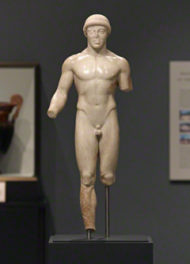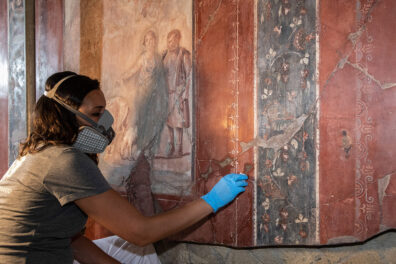
Conservators learn how to perform analysis of biological growth in a cemetery in Rome during the International Course on Stone Conservation. Photo: Scott Warren for the GCI
Staff members of the Getty Conservation Institute (GCI) come from a great variety of disciplines. Chemists, architects, biologists, conservators, engineers, and other specialists lend their expertise to advance conservation of the world’s cultural heritage. Just as diverse as the staff’s backgrounds are the types of tools they use to aid the Institute’s conservation efforts.
The Conservation Institute’s work to conserve cultural heritage takes staff to locations throughout the world. When they travel miles away from our labs and offices at the Getty Center, what tools do our project staff bring to their campaigns?
Benjamin Marcus, a project specialist, specializes in stone conservation. When he’s working out in the field to analyze stone monuments and buildings, he brings with him a USB digital microscope to identify the types of stones and to examine their deterioration.
What Does the Tool Do?
The digital microscope, small and light enough to be held comfortably in your hand, connects to a laptop computer via USB cable. Instead of looking through an eyepiece like you would with a tabletop microscope, users see images of the magnified objects on their computer monitor. Think webcam, but with high magnification powers and built-in LED lights to illuminate the object being examined. Because of their portability, USB microscopes are useful for analyzing monuments in situations that can be hard to reach with bulky equipment.
How Does It Advance Conservation Practice?
As the project manager of the International Course on Stone Conservation, held every two years in partnership with ICCROM in Rome, Ben trains conservation professionals to perform different kinds of analysis in the field. The digital microscope is an important tool to help identify types of stone, such as marble or limestone, as well as to analyze the components in mortars. Working directly on a computer, users can easily take pictures or videos for documentation and carry out further analysis, such as measuring the size of the sand granules in mortar.
The USB microscope is also useful as a diagnostic tool for identifying the source of the stone’s deterioration, helping to identify salts, pollution and biological growth. It can even locate historic tool marks and past conservation treatments. When course participants were examining black stains on a marble monument in a cemetery in Rome, Ben explains that “what looked like black deposits from pollution to the naked eye turned out to be fungus or algae growing on the surface.”

Micrograph of sandstone with micro fissure and biological growth.
Without digital microscopes, conservators in the field can use handheld loupes for analysis. However, their magnification powers only go up to about 30x, which means that samples still need to be taken and brought to a laboratory for proper microscopy or other analysis. With the USB microscope offering a magnification power of up to 250x, “you can perform a high level analysis right out in the field,” says Ben.
Once conservators have looked at the stone with the USB microscope, they can take samples, for example, of each kind of biological growth and bring them back to the lab for further analysis. The information can then be used to decide treatment plans for the long-term care and conservation of the stone monuments and buildings.
The USB microscope has proven to be a cost-effective tool that has greatly sped up the analytical process in conservation studies not only of stone but also of other types of materials. The portable digital microscope is used in many other Conservation Institute field projects including the Conservation and Rehabilitation Plan for the Kasbah of Taourirt in southern Morocco, where it is used to perform detailed analyses of wall paintings.




What model digital microscope does Ben use? They have quite a range in quality and features.
Hi Christine,
This is a really interesting article. I have seen some of those USB digital microscopes sold online and range from as little as $10 up to $1000 or even more. One model I have seen is claimed to reach 400X despite its non-expensive price at about $70. So which model of those microscopes is preferred in the projects you mentioned in the article? Or at least what is their price range?
Thanks for your interest! Ben says, “We’ve used several microscopes of varying quality but currently have an AM4515ZTL Dino-Lite Edge microscope. This is a very good microscope with excellent resolution and software for field applications.” And here’s a product link on Microscope.com, which shows various package options.
—Annelisa / Iris editor
Thank you very much for your prompt reply and for the useful information you kindly provided.
I used a Dinolite for my honours research a couple of years ago. One of my supervisors use it in the field in remote areas. Helpful when you cannot bring artefacts back to a lab.
I will consider getting one myself for future use.
Looks a useful piece of kit. I would be interested in a similar post on USB endoscopes for building conservation/surveying if this is on your horizon?
Best wishes
Andrew Harris